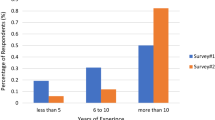Abstract
As the economy in China enters the new normal, Public-Private Partnerships have been an important measure for alleviating financial tensions and improving the administrative efficiency of the government. Based on the mode of open tendering for the selection of social capital partners for the new profit project, the open tendering procedures were analyzed. In addition, based on an improved TOPSIS model, the evaluation index system for the selection conducts a comprehensive evaluation of six aspects: reputation and performance, water pricing factor, financing program, construction program, operation and maintenance program, and transfer program.
Similar content being viewed by others
References
Abrera, J., Parham, A., and McDonough, J. F. (2010). “Public-private partnership, information technology, and operational efficiency at Sandy Springs, Georgia.” IBM Journal of Research and Development, Vol. 55, Nos. 1–2, pp. 148–162, DOI: 10.1147/JRD.2010.2097090.
Chua, D. K. H., Kog, Y. C., and Loh, P. K. (1999). “Critical success factor for different project objectives.” Journal of Construction Engineering Management, Vol. 125, No. 3, pp. 142–150, DOI: 10.1061/(ASCE)0733-9364(1999)125:3(142).
Dodd, A. J., Ainsworth, N., Hauser, C. E., Burgman, M. A., McCarthy, M. A. (2017). “Prioritizing plant eradication targets by re-framing the Project Prioritization Protocol (PPP) for use in biosecurity applications.” Biological Invasions, Vol. 19, No. 3, pp. 859–873, DOI: 10.1007/s10530-016-1335-7.
Fatemeh Torfi and Abbas Rashidi (2011). “Selection of project managers in construction firms using Analytic Hierarchy Process (AHP) and Fuzzy Topsis: A case study.” Journal of Construction in Develo** Countries, Vol. 16, No. 1, pp. 69–89.
Ford, N. and Horioka, C. (2017). “The ‘real’ explanation of the PPP puzzle.” Applied Economics Letters, Vol. 24, No. 5, pp. 325–328, DOI: 10.1080/13504851.2016.1186790.
Xu-Kuo, G. and **ao-Hu, C. (2013). “Partner selection about the ppp reclaimed water project based on extension evaluation method.” 19th International Conference on Industrial Engineering and Engineering Management: Assistive Technology of Industrial Engineering, pp. 411–417.
Gupta, M. C. and Narasimham, S. V. (1998). “Discussion of ‘CSFs in competitive tendering and negotiation model for BOT projects’ by R. L. K. Tiong.” Journal of Construction Engineering Management, Vol. 124, No. 5, p. 430, DOI: 10.1061/(ASCE)0733-9364(1998) 124:5(430).
Gurgun, A. P. and Touran, A. (2014). “Public-private partnership experience in the international arena: Case of Turkey.” Journal of Management in Engineering, Vol. 30, No. 6, pp. 1128–1242, DOI: 10.1061/(ASCE)ME.1943-5479.0000213.
Hwang, B. G., Zhao, X. B., and Gay, M. (2012). “Public private partnership projects in Singapore: Factors, critical risks and preferred risk allocation from the perspective of contractors.” International Journal of Project Management, Vol. 31, No. 3, pp. 424–433, DOI: 10.1016/j.ijproman.2012.08.003.
Iyer, K. C. and Sagheer, M. (2010). “Hierarchical structuring of PPP risks using interpretative structural modeling.” Journal of Construction Engineering and Management, Vol. 136, No. 2, pp. 151–159, DOI: 10.1061/(ASCE)CO.1943-7862.0000127.
Song, J., Hu, Y., and Feng, Z. (2018). “Factors Influencing Early Termination of PPP Projects in China.” Journal of Management in Engineering, Vol. 34, No. 1, pp. 05017008–1-05017008-10, DOI: 10.1061/(ASCE)ME.1943-5479.0000572.
Kosoy N., Martinez T. M., Muradian R., Martinez-Alier J. (2007). “Payments for environmental services in watersheds: Insights from a comparative study of three cases in Central America.” Ecological economics, Vol. 61, Nos. 2–3, pp. 446–455, DOI: 10.1016/j.ecolecon.2006.03.016.
Lee, C. H. and Yu, Y. H. (2011). “Service delivery comparisons on household connections in Taiwan's sewer public-private-partnership (PPP) projects.” International Journal of Project Management, Vol. 29, No. 8, pp. 1033–1043, DOI: 10.1016/j.ijproman.2010.11.005.
Mahalingam, A. (2010). “PPP experiences in Indian cities: Barriers, enablers, and the way forward.” Journal of Construction Engineering and Management, Vol. 136, No. 4, pp. 419–429, DOI: 10.1061/(ASCE)CO.1943-7862.0000130.
Meduri, S. S. and Annamalai, T. R. (2017) “Unit costs of public and PPP road projects: Evidence from India.” Journal of Construction Engineering and Management, Vol. 139, No. 1, pp. 35–43, DOI: 10.1061/(ASCE)CO.1943-7862.0000546.
Ouenniche J., Boukouras A., and Mohammad, R. (2016). “An ordinal game theory approach to the analysis and selection of partners in public-private partnership projects.” Journal of Optimization Theory and Application, Vol. 169, No. 1, pp. 314–343, DOI: 10.1007/s10957-015-0844-3.
Sahooly, A. (2003). “Public-private partnership in the water supply and sanitation sector: The experience of the Republic of Yemen.” International Journal of Water Resources Development, Vol. 19, No. 2, pp. 139–152, DOI: 10.1080/0790062032000089275.
Sardenne, F., Kraffe, E., Amiel, A., Fouche, E., Debrauwer, L, Ménard, F., and Bodin, N. (2017). “Biological and environmental influence on tissue fatty acid compositions in wild tropical tunas.” Comparative biochemistry and physiology. Part A, Molecular & Integrative Physiology, Vol. 204, pp. 17–27, DOI: 10.1016/j.cbpa.2016.11.007.
Suh, Y. J., Shin, J., Kang, M., and Sung, J. (2017). “Genetic and Environmental Influences on General Skin Traits: Healthy Twins and Families in Korea.” Twin Research and Human Genetics: The Official Journal of the International Society for Twin Studies, Vol. 20, No. 1, pp. 36–42, DOI: 10.1017/thg.2016.86.
Tiong, R. L. K. and Alum, J. (1997). “Distinctive winning elements in BOT tender.” Engineering, Construction and Architectural Management, Vol. 4, No. 2, pp. 83–94, DOI: 10.1108/eb021041.
Wen-xiong, W., Qi-ming, L., **ao-peng, D., Li-hua, L., and Yuan, C. (2007). “Selecting optimal private-sector partner in infrastructure projects under PPP model.” Proceedings of 2007 International Conference on Management Science & Engineering (14th), Vols. 1–3, pp. 2264–2270, DOI:10.1109/ICMSE.2007.4422176.
Xue-Qqing, Z. (2005). “Criteria for selecting the private-sector partner in public-private partnerships.” Journal of Construction Engineering and Management, Vol. 131, No. 6, pp. 631–644, DOI:10.1061/(ASCE)0733-9364(2005)131:6(631).
Author information
Authors and Affiliations
Corresponding author
Rights and permissions
About this article
Cite this article
Liu, B., Shen, Jq., Meng, Zj. et al. A Survey on the Establishment and Application of Social Capital Partner Selection System for the New Profit PPP Project. KSCE J Civ Eng 22, 3726–3737 (2018). https://doi.org/10.1007/s12205-018-0489-5
Received:
Revised:
Accepted:
Published:
Issue Date:
DOI: https://doi.org/10.1007/s12205-018-0489-5




